Strategic People Management in NHS: Enhancing HR and Leadership
VerifiedAdded on 2023/01/12
|11
|2669
|97
Report
AI Summary
This report examines strategic people management within the National Health Service (NHS) of the UK, focusing on key areas such as leadership and management, training and development, and talent management. It addresses the pressures faced by the NHS and the need for changes in human resources and leadership operations. The report advocates for the implementation of participative leadership and scientific management theories to improve decision-making, recruitment, and overall efficiency. It also recommends incorporating the Bloom's Taxonomy model of Cognitive Learning to enhance training and development programs. Furthermore, the report emphasizes the importance of talent management practices for retaining skilled staff and aligning their efforts with organizational goals. It highlights the collaborative roles of NHS managers and the Human Resources department in operational staffing, performance management, and workforce planning to support effective NHS management.
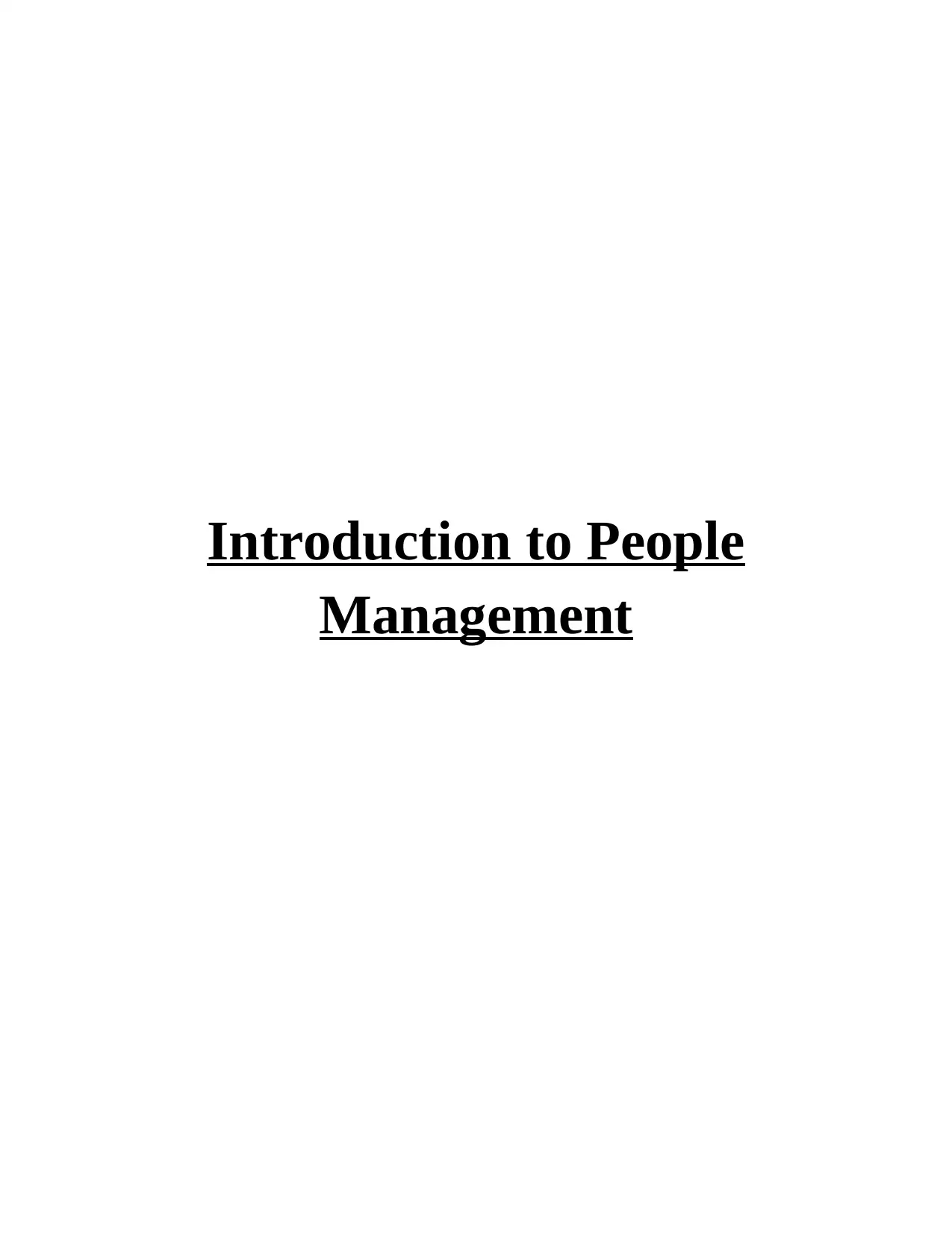
Introduction to People
Management
Management
Paraphrase This Document
Need a fresh take? Get an instant paraphrase of this document with our AI Paraphraser
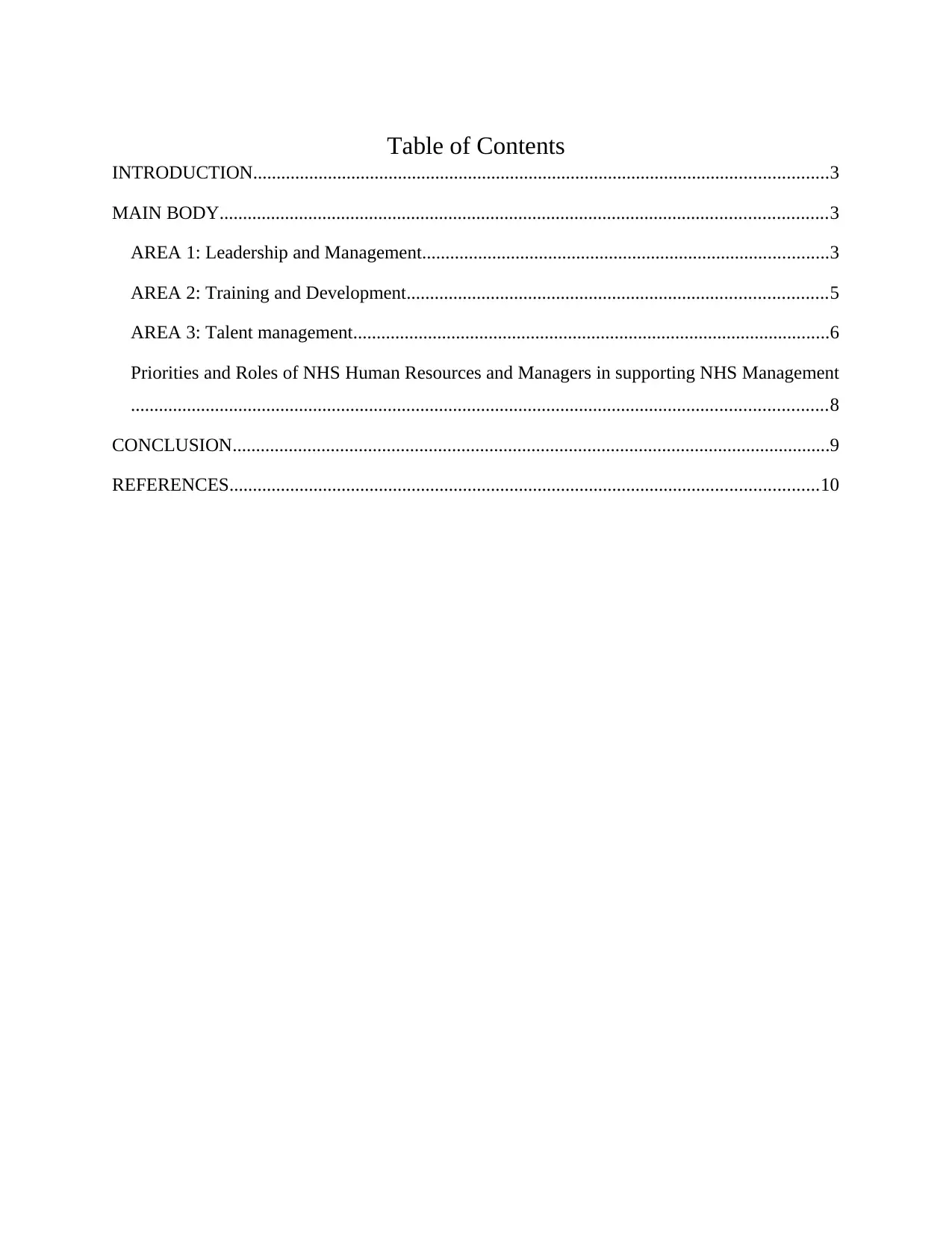
Table of Contents
INTRODUCTION...........................................................................................................................3
MAIN BODY..................................................................................................................................3
AREA 1: Leadership and Management.......................................................................................3
AREA 2: Training and Development..........................................................................................5
AREA 3: Talent management......................................................................................................6
Priorities and Roles of NHS Human Resources and Managers in supporting NHS Management
.....................................................................................................................................................8
CONCLUSION................................................................................................................................9
REFERENCES..............................................................................................................................10
INTRODUCTION...........................................................................................................................3
MAIN BODY..................................................................................................................................3
AREA 1: Leadership and Management.......................................................................................3
AREA 2: Training and Development..........................................................................................5
AREA 3: Talent management......................................................................................................6
Priorities and Roles of NHS Human Resources and Managers in supporting NHS Management
.....................................................................................................................................................8
CONCLUSION................................................................................................................................9
REFERENCES..............................................................................................................................10
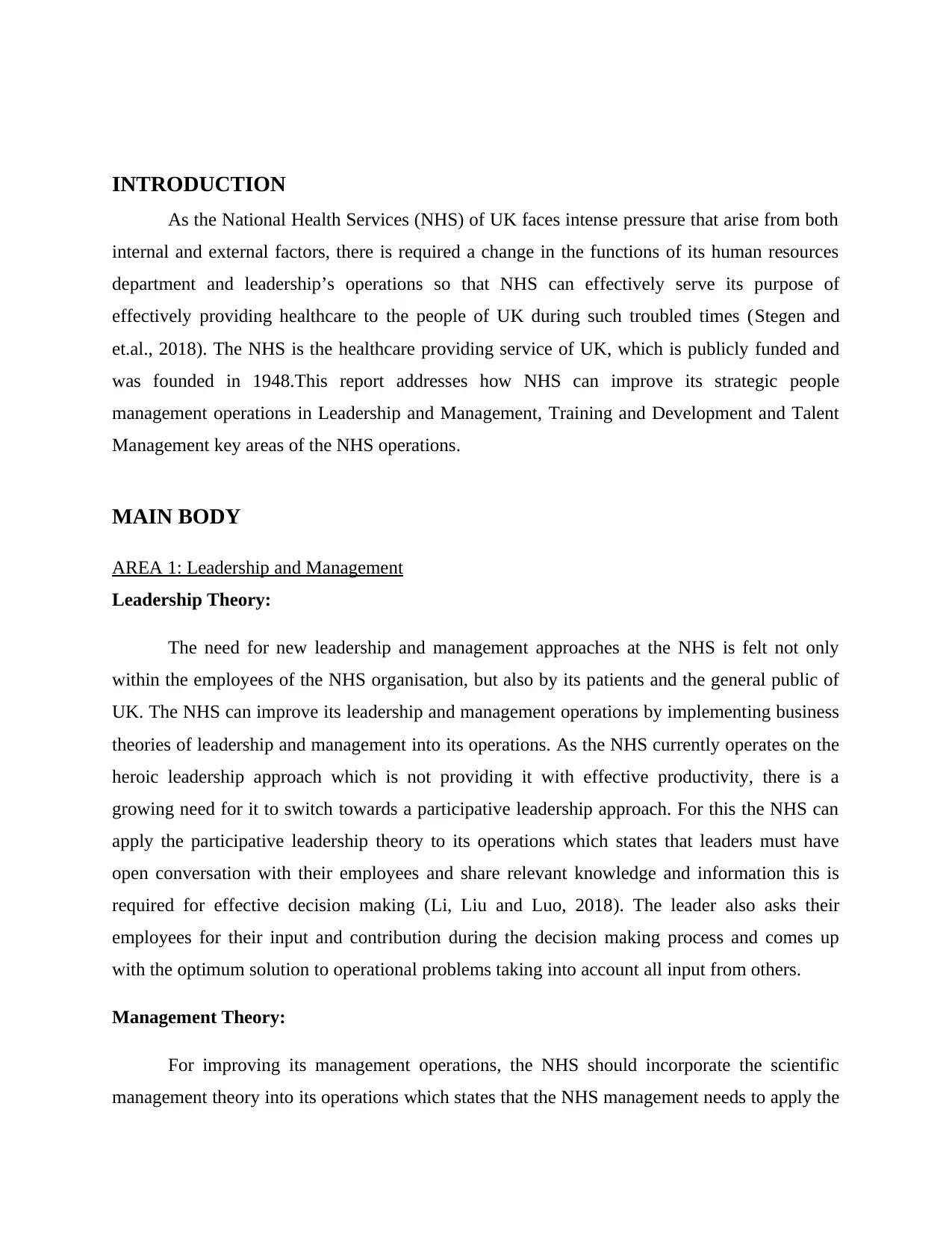
INTRODUCTION
As the National Health Services (NHS) of UK faces intense pressure that arise from both
internal and external factors, there is required a change in the functions of its human resources
department and leadership’s operations so that NHS can effectively serve its purpose of
effectively providing healthcare to the people of UK during such troubled times (Stegen and
et.al., 2018). The NHS is the healthcare providing service of UK, which is publicly funded and
was founded in 1948.This report addresses how NHS can improve its strategic people
management operations in Leadership and Management, Training and Development and Talent
Management key areas of the NHS operations.
MAIN BODY
AREA 1: Leadership and Management
Leadership Theory:
The need for new leadership and management approaches at the NHS is felt not only
within the employees of the NHS organisation, but also by its patients and the general public of
UK. The NHS can improve its leadership and management operations by implementing business
theories of leadership and management into its operations. As the NHS currently operates on the
heroic leadership approach which is not providing it with effective productivity, there is a
growing need for it to switch towards a participative leadership approach. For this the NHS can
apply the participative leadership theory to its operations which states that leaders must have
open conversation with their employees and share relevant knowledge and information this is
required for effective decision making (Li, Liu and Luo, 2018). The leader also asks their
employees for their input and contribution during the decision making process and comes up
with the optimum solution to operational problems taking into account all input from others.
Management Theory:
For improving its management operations, the NHS should incorporate the scientific
management theory into its operations which states that the NHS management needs to apply the
As the National Health Services (NHS) of UK faces intense pressure that arise from both
internal and external factors, there is required a change in the functions of its human resources
department and leadership’s operations so that NHS can effectively serve its purpose of
effectively providing healthcare to the people of UK during such troubled times (Stegen and
et.al., 2018). The NHS is the healthcare providing service of UK, which is publicly funded and
was founded in 1948.This report addresses how NHS can improve its strategic people
management operations in Leadership and Management, Training and Development and Talent
Management key areas of the NHS operations.
MAIN BODY
AREA 1: Leadership and Management
Leadership Theory:
The need for new leadership and management approaches at the NHS is felt not only
within the employees of the NHS organisation, but also by its patients and the general public of
UK. The NHS can improve its leadership and management operations by implementing business
theories of leadership and management into its operations. As the NHS currently operates on the
heroic leadership approach which is not providing it with effective productivity, there is a
growing need for it to switch towards a participative leadership approach. For this the NHS can
apply the participative leadership theory to its operations which states that leaders must have
open conversation with their employees and share relevant knowledge and information this is
required for effective decision making (Li, Liu and Luo, 2018). The leader also asks their
employees for their input and contribution during the decision making process and comes up
with the optimum solution to operational problems taking into account all input from others.
Management Theory:
For improving its management operations, the NHS should incorporate the scientific
management theory into its operations which states that the NHS management needs to apply the
⊘ This is a preview!⊘
Do you want full access?
Subscribe today to unlock all pages.

Trusted by 1+ million students worldwide
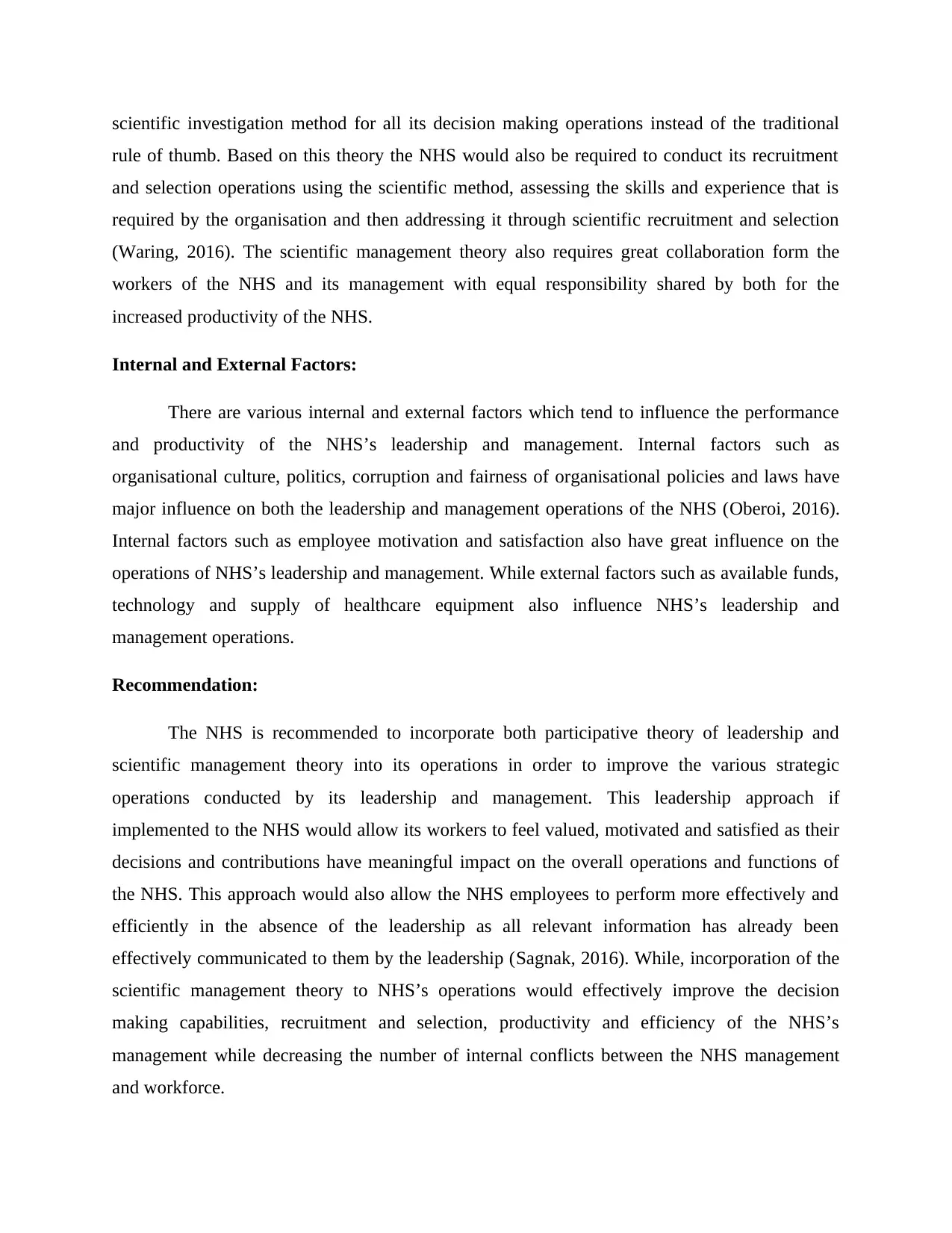
scientific investigation method for all its decision making operations instead of the traditional
rule of thumb. Based on this theory the NHS would also be required to conduct its recruitment
and selection operations using the scientific method, assessing the skills and experience that is
required by the organisation and then addressing it through scientific recruitment and selection
(Waring, 2016). The scientific management theory also requires great collaboration form the
workers of the NHS and its management with equal responsibility shared by both for the
increased productivity of the NHS.
Internal and External Factors:
There are various internal and external factors which tend to influence the performance
and productivity of the NHS’s leadership and management. Internal factors such as
organisational culture, politics, corruption and fairness of organisational policies and laws have
major influence on both the leadership and management operations of the NHS (Oberoi, 2016).
Internal factors such as employee motivation and satisfaction also have great influence on the
operations of NHS’s leadership and management. While external factors such as available funds,
technology and supply of healthcare equipment also influence NHS’s leadership and
management operations.
Recommendation:
The NHS is recommended to incorporate both participative theory of leadership and
scientific management theory into its operations in order to improve the various strategic
operations conducted by its leadership and management. This leadership approach if
implemented to the NHS would allow its workers to feel valued, motivated and satisfied as their
decisions and contributions have meaningful impact on the overall operations and functions of
the NHS. This approach would also allow the NHS employees to perform more effectively and
efficiently in the absence of the leadership as all relevant information has already been
effectively communicated to them by the leadership (Sagnak, 2016). While, incorporation of the
scientific management theory to NHS’s operations would effectively improve the decision
making capabilities, recruitment and selection, productivity and efficiency of the NHS’s
management while decreasing the number of internal conflicts between the NHS management
and workforce.
rule of thumb. Based on this theory the NHS would also be required to conduct its recruitment
and selection operations using the scientific method, assessing the skills and experience that is
required by the organisation and then addressing it through scientific recruitment and selection
(Waring, 2016). The scientific management theory also requires great collaboration form the
workers of the NHS and its management with equal responsibility shared by both for the
increased productivity of the NHS.
Internal and External Factors:
There are various internal and external factors which tend to influence the performance
and productivity of the NHS’s leadership and management. Internal factors such as
organisational culture, politics, corruption and fairness of organisational policies and laws have
major influence on both the leadership and management operations of the NHS (Oberoi, 2016).
Internal factors such as employee motivation and satisfaction also have great influence on the
operations of NHS’s leadership and management. While external factors such as available funds,
technology and supply of healthcare equipment also influence NHS’s leadership and
management operations.
Recommendation:
The NHS is recommended to incorporate both participative theory of leadership and
scientific management theory into its operations in order to improve the various strategic
operations conducted by its leadership and management. This leadership approach if
implemented to the NHS would allow its workers to feel valued, motivated and satisfied as their
decisions and contributions have meaningful impact on the overall operations and functions of
the NHS. This approach would also allow the NHS employees to perform more effectively and
efficiently in the absence of the leadership as all relevant information has already been
effectively communicated to them by the leadership (Sagnak, 2016). While, incorporation of the
scientific management theory to NHS’s operations would effectively improve the decision
making capabilities, recruitment and selection, productivity and efficiency of the NHS’s
management while decreasing the number of internal conflicts between the NHS management
and workforce.
Paraphrase This Document
Need a fresh take? Get an instant paraphrase of this document with our AI Paraphraser
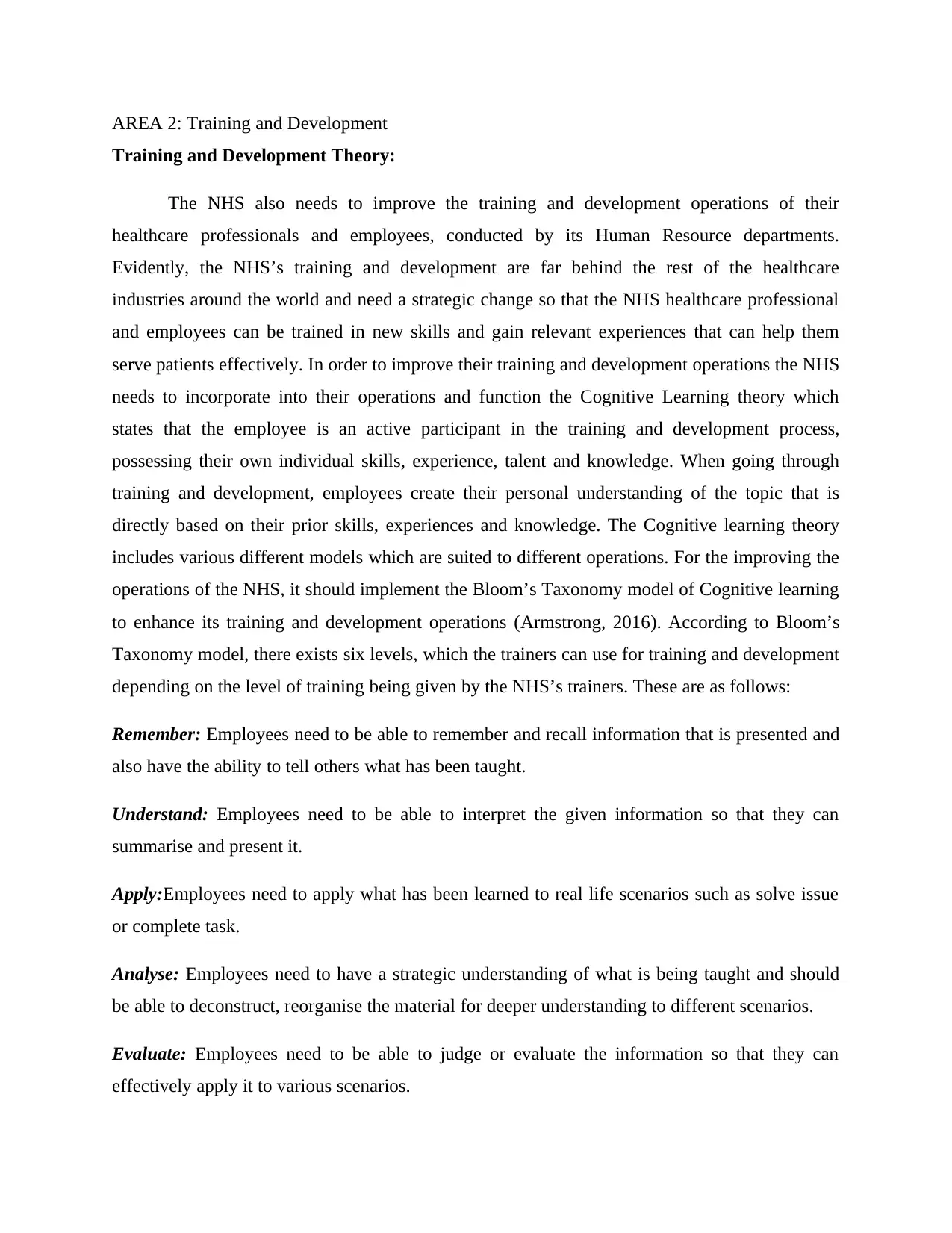
AREA 2: Training and Development
Training and Development Theory:
The NHS also needs to improve the training and development operations of their
healthcare professionals and employees, conducted by its Human Resource departments.
Evidently, the NHS’s training and development are far behind the rest of the healthcare
industries around the world and need a strategic change so that the NHS healthcare professional
and employees can be trained in new skills and gain relevant experiences that can help them
serve patients effectively. In order to improve their training and development operations the NHS
needs to incorporate into their operations and function the Cognitive Learning theory which
states that the employee is an active participant in the training and development process,
possessing their own individual skills, experience, talent and knowledge. When going through
training and development, employees create their personal understanding of the topic that is
directly based on their prior skills, experiences and knowledge. The Cognitive learning theory
includes various different models which are suited to different operations. For the improving the
operations of the NHS, it should implement the Bloom’s Taxonomy model of Cognitive learning
to enhance its training and development operations (Armstrong, 2016). According to Bloom’s
Taxonomy model, there exists six levels, which the trainers can use for training and development
depending on the level of training being given by the NHS’s trainers. These are as follows:
Remember: Employees need to be able to remember and recall information that is presented and
also have the ability to tell others what has been taught.
Understand: Employees need to be able to interpret the given information so that they can
summarise and present it.
Apply:Employees need to apply what has been learned to real life scenarios such as solve issue
or complete task.
Analyse: Employees need to have a strategic understanding of what is being taught and should
be able to deconstruct, reorganise the material for deeper understanding to different scenarios.
Evaluate: Employees need to be able to judge or evaluate the information so that they can
effectively apply it to various scenarios.
Training and Development Theory:
The NHS also needs to improve the training and development operations of their
healthcare professionals and employees, conducted by its Human Resource departments.
Evidently, the NHS’s training and development are far behind the rest of the healthcare
industries around the world and need a strategic change so that the NHS healthcare professional
and employees can be trained in new skills and gain relevant experiences that can help them
serve patients effectively. In order to improve their training and development operations the NHS
needs to incorporate into their operations and function the Cognitive Learning theory which
states that the employee is an active participant in the training and development process,
possessing their own individual skills, experience, talent and knowledge. When going through
training and development, employees create their personal understanding of the topic that is
directly based on their prior skills, experiences and knowledge. The Cognitive learning theory
includes various different models which are suited to different operations. For the improving the
operations of the NHS, it should implement the Bloom’s Taxonomy model of Cognitive learning
to enhance its training and development operations (Armstrong, 2016). According to Bloom’s
Taxonomy model, there exists six levels, which the trainers can use for training and development
depending on the level of training being given by the NHS’s trainers. These are as follows:
Remember: Employees need to be able to remember and recall information that is presented and
also have the ability to tell others what has been taught.
Understand: Employees need to be able to interpret the given information so that they can
summarise and present it.
Apply:Employees need to apply what has been learned to real life scenarios such as solve issue
or complete task.
Analyse: Employees need to have a strategic understanding of what is being taught and should
be able to deconstruct, reorganise the material for deeper understanding to different scenarios.
Evaluate: Employees need to be able to judge or evaluate the information so that they can
effectively apply it to various scenarios.
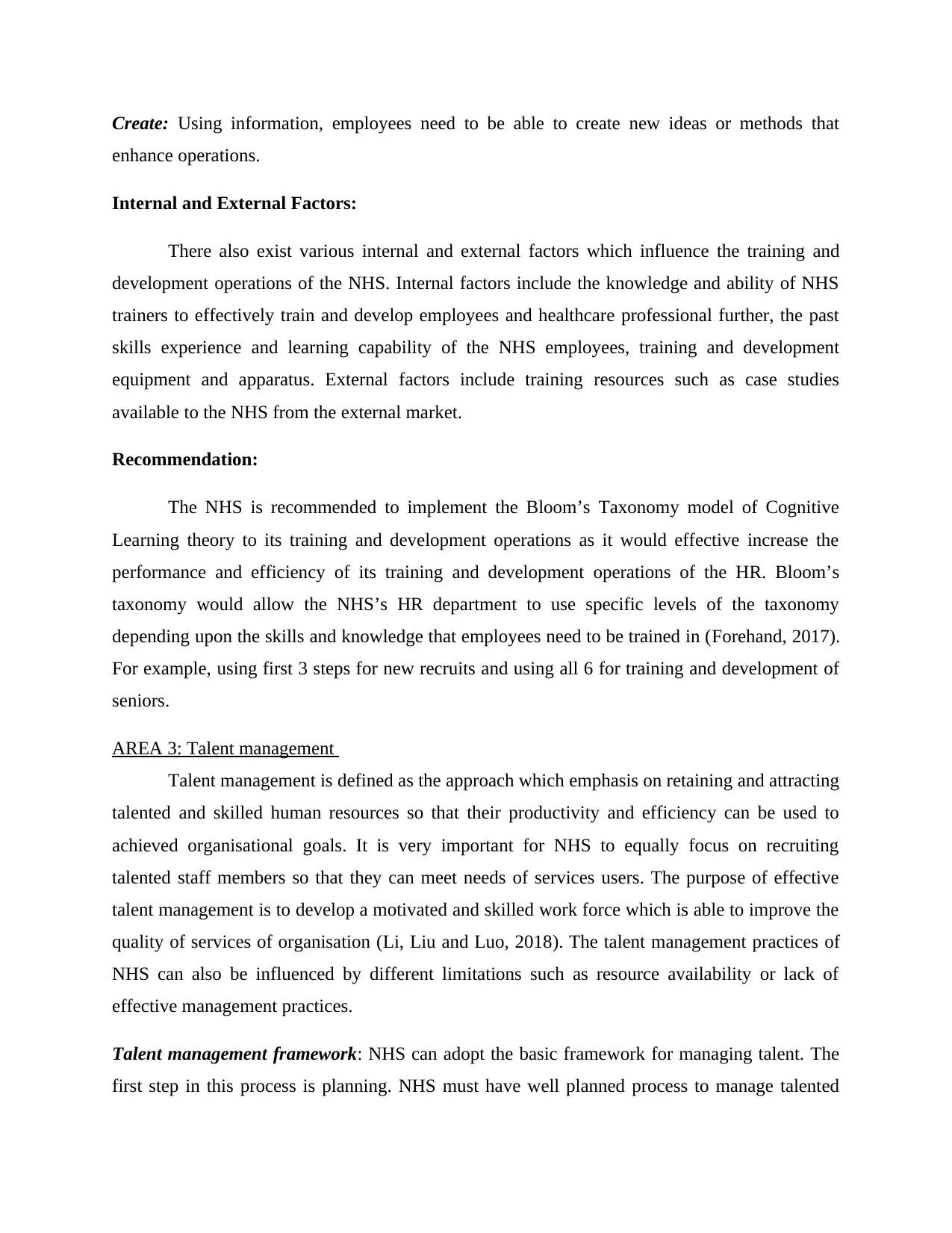
Create: Using information, employees need to be able to create new ideas or methods that
enhance operations.
Internal and External Factors:
There also exist various internal and external factors which influence the training and
development operations of the NHS. Internal factors include the knowledge and ability of NHS
trainers to effectively train and develop employees and healthcare professional further, the past
skills experience and learning capability of the NHS employees, training and development
equipment and apparatus. External factors include training resources such as case studies
available to the NHS from the external market.
Recommendation:
The NHS is recommended to implement the Bloom’s Taxonomy model of Cognitive
Learning theory to its training and development operations as it would effective increase the
performance and efficiency of its training and development operations of the HR. Bloom’s
taxonomy would allow the NHS’s HR department to use specific levels of the taxonomy
depending upon the skills and knowledge that employees need to be trained in (Forehand, 2017).
For example, using first 3 steps for new recruits and using all 6 for training and development of
seniors.
AREA 3: Talent management
Talent management is defined as the approach which emphasis on retaining and attracting
talented and skilled human resources so that their productivity and efficiency can be used to
achieved organisational goals. It is very important for NHS to equally focus on recruiting
talented staff members so that they can meet needs of services users. The purpose of effective
talent management is to develop a motivated and skilled work force which is able to improve the
quality of services of organisation (Li, Liu and Luo, 2018). The talent management practices of
NHS can also be influenced by different limitations such as resource availability or lack of
effective management practices.
Talent management framework: NHS can adopt the basic framework for managing talent. The
first step in this process is planning. NHS must have well planned process to manage talented
enhance operations.
Internal and External Factors:
There also exist various internal and external factors which influence the training and
development operations of the NHS. Internal factors include the knowledge and ability of NHS
trainers to effectively train and develop employees and healthcare professional further, the past
skills experience and learning capability of the NHS employees, training and development
equipment and apparatus. External factors include training resources such as case studies
available to the NHS from the external market.
Recommendation:
The NHS is recommended to implement the Bloom’s Taxonomy model of Cognitive
Learning theory to its training and development operations as it would effective increase the
performance and efficiency of its training and development operations of the HR. Bloom’s
taxonomy would allow the NHS’s HR department to use specific levels of the taxonomy
depending upon the skills and knowledge that employees need to be trained in (Forehand, 2017).
For example, using first 3 steps for new recruits and using all 6 for training and development of
seniors.
AREA 3: Talent management
Talent management is defined as the approach which emphasis on retaining and attracting
talented and skilled human resources so that their productivity and efficiency can be used to
achieved organisational goals. It is very important for NHS to equally focus on recruiting
talented staff members so that they can meet needs of services users. The purpose of effective
talent management is to develop a motivated and skilled work force which is able to improve the
quality of services of organisation (Li, Liu and Luo, 2018). The talent management practices of
NHS can also be influenced by different limitations such as resource availability or lack of
effective management practices.
Talent management framework: NHS can adopt the basic framework for managing talent. The
first step in this process is planning. NHS must have well planned process to manage talented
⊘ This is a preview!⊘
Do you want full access?
Subscribe today to unlock all pages.

Trusted by 1+ million students worldwide
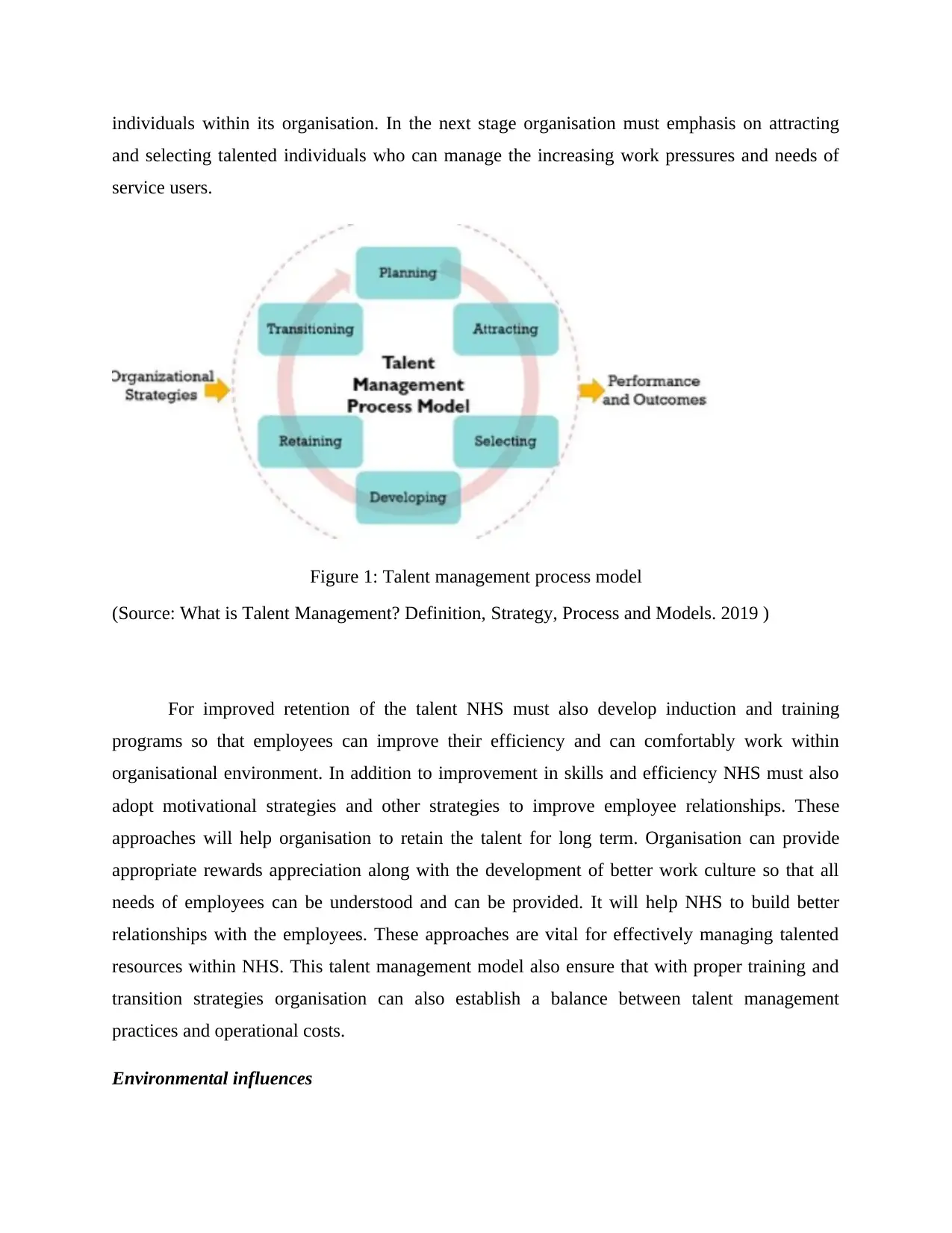
individuals within its organisation. In the next stage organisation must emphasis on attracting
and selecting talented individuals who can manage the increasing work pressures and needs of
service users.
Figure 1: Talent management process model
(Source: What is Talent Management? Definition, Strategy, Process and Models. 2019 )
For improved retention of the talent NHS must also develop induction and training
programs so that employees can improve their efficiency and can comfortably work within
organisational environment. In addition to improvement in skills and efficiency NHS must also
adopt motivational strategies and other strategies to improve employee relationships. These
approaches will help organisation to retain the talent for long term. Organisation can provide
appropriate rewards appreciation along with the development of better work culture so that all
needs of employees can be understood and can be provided. It will help NHS to build better
relationships with the employees. These approaches are vital for effectively managing talented
resources within NHS. This talent management model also ensure that with proper training and
transition strategies organisation can also establish a balance between talent management
practices and operational costs.
Environmental influences
and selecting talented individuals who can manage the increasing work pressures and needs of
service users.
Figure 1: Talent management process model
(Source: What is Talent Management? Definition, Strategy, Process and Models. 2019 )
For improved retention of the talent NHS must also develop induction and training
programs so that employees can improve their efficiency and can comfortably work within
organisational environment. In addition to improvement in skills and efficiency NHS must also
adopt motivational strategies and other strategies to improve employee relationships. These
approaches will help organisation to retain the talent for long term. Organisation can provide
appropriate rewards appreciation along with the development of better work culture so that all
needs of employees can be understood and can be provided. It will help NHS to build better
relationships with the employees. These approaches are vital for effectively managing talented
resources within NHS. This talent management model also ensure that with proper training and
transition strategies organisation can also establish a balance between talent management
practices and operational costs.
Environmental influences
Paraphrase This Document
Need a fresh take? Get an instant paraphrase of this document with our AI Paraphraser
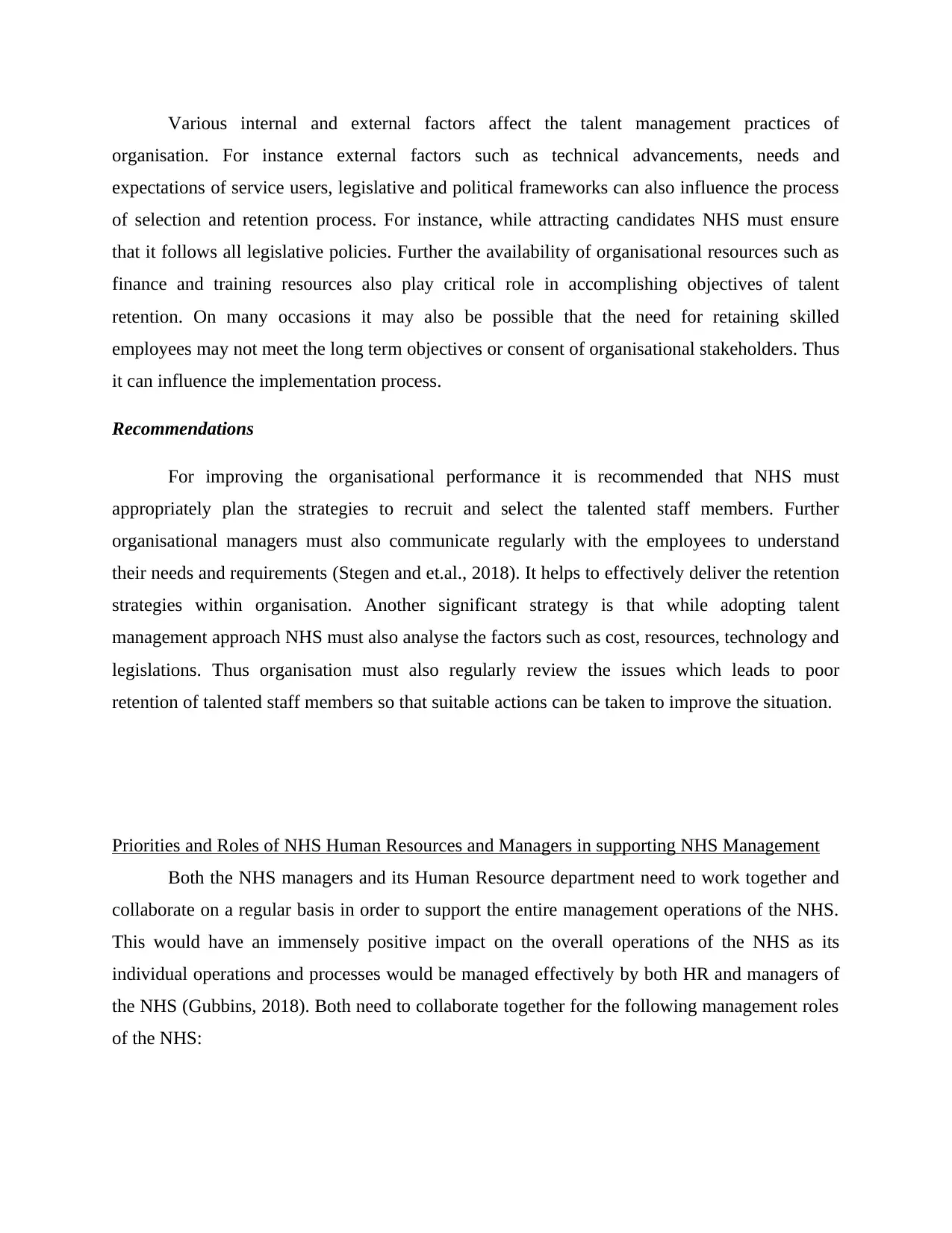
Various internal and external factors affect the talent management practices of
organisation. For instance external factors such as technical advancements, needs and
expectations of service users, legislative and political frameworks can also influence the process
of selection and retention process. For instance, while attracting candidates NHS must ensure
that it follows all legislative policies. Further the availability of organisational resources such as
finance and training resources also play critical role in accomplishing objectives of talent
retention. On many occasions it may also be possible that the need for retaining skilled
employees may not meet the long term objectives or consent of organisational stakeholders. Thus
it can influence the implementation process.
Recommendations
For improving the organisational performance it is recommended that NHS must
appropriately plan the strategies to recruit and select the talented staff members. Further
organisational managers must also communicate regularly with the employees to understand
their needs and requirements (Stegen and et.al., 2018). It helps to effectively deliver the retention
strategies within organisation. Another significant strategy is that while adopting talent
management approach NHS must also analyse the factors such as cost, resources, technology and
legislations. Thus organisation must also regularly review the issues which leads to poor
retention of talented staff members so that suitable actions can be taken to improve the situation.
Priorities and Roles of NHS Human Resources and Managers in supporting NHS Management
Both the NHS managers and its Human Resource department need to work together and
collaborate on a regular basis in order to support the entire management operations of the NHS.
This would have an immensely positive impact on the overall operations of the NHS as its
individual operations and processes would be managed effectively by both HR and managers of
the NHS (Gubbins, 2018). Both need to collaborate together for the following management roles
of the NHS:
organisation. For instance external factors such as technical advancements, needs and
expectations of service users, legislative and political frameworks can also influence the process
of selection and retention process. For instance, while attracting candidates NHS must ensure
that it follows all legislative policies. Further the availability of organisational resources such as
finance and training resources also play critical role in accomplishing objectives of talent
retention. On many occasions it may also be possible that the need for retaining skilled
employees may not meet the long term objectives or consent of organisational stakeholders. Thus
it can influence the implementation process.
Recommendations
For improving the organisational performance it is recommended that NHS must
appropriately plan the strategies to recruit and select the talented staff members. Further
organisational managers must also communicate regularly with the employees to understand
their needs and requirements (Stegen and et.al., 2018). It helps to effectively deliver the retention
strategies within organisation. Another significant strategy is that while adopting talent
management approach NHS must also analyse the factors such as cost, resources, technology and
legislations. Thus organisation must also regularly review the issues which leads to poor
retention of talented staff members so that suitable actions can be taken to improve the situation.
Priorities and Roles of NHS Human Resources and Managers in supporting NHS Management
Both the NHS managers and its Human Resource department need to work together and
collaborate on a regular basis in order to support the entire management operations of the NHS.
This would have an immensely positive impact on the overall operations of the NHS as its
individual operations and processes would be managed effectively by both HR and managers of
the NHS (Gubbins, 2018). Both need to collaborate together for the following management roles
of the NHS:
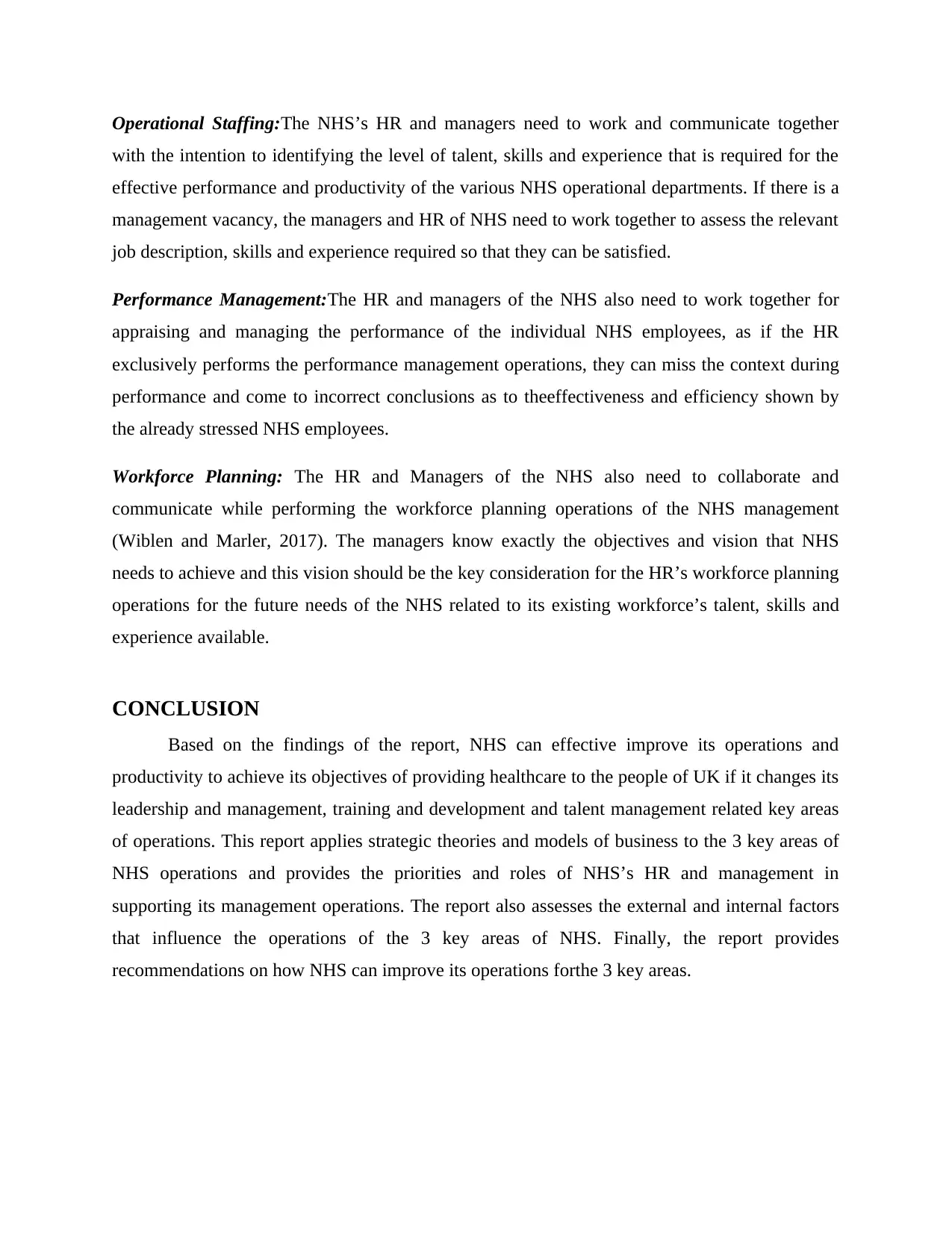
Operational Staffing:The NHS’s HR and managers need to work and communicate together
with the intention to identifying the level of talent, skills and experience that is required for the
effective performance and productivity of the various NHS operational departments. If there is a
management vacancy, the managers and HR of NHS need to work together to assess the relevant
job description, skills and experience required so that they can be satisfied.
Performance Management:The HR and managers of the NHS also need to work together for
appraising and managing the performance of the individual NHS employees, as if the HR
exclusively performs the performance management operations, they can miss the context during
performance and come to incorrect conclusions as to theeffectiveness and efficiency shown by
the already stressed NHS employees.
Workforce Planning: The HR and Managers of the NHS also need to collaborate and
communicate while performing the workforce planning operations of the NHS management
(Wiblen and Marler, 2017). The managers know exactly the objectives and vision that NHS
needs to achieve and this vision should be the key consideration for the HR’s workforce planning
operations for the future needs of the NHS related to its existing workforce’s talent, skills and
experience available.
CONCLUSION
Based on the findings of the report, NHS can effective improve its operations and
productivity to achieve its objectives of providing healthcare to the people of UK if it changes its
leadership and management, training and development and talent management related key areas
of operations. This report applies strategic theories and models of business to the 3 key areas of
NHS operations and provides the priorities and roles of NHS’s HR and management in
supporting its management operations. The report also assesses the external and internal factors
that influence the operations of the 3 key areas of NHS. Finally, the report provides
recommendations on how NHS can improve its operations forthe 3 key areas.
with the intention to identifying the level of talent, skills and experience that is required for the
effective performance and productivity of the various NHS operational departments. If there is a
management vacancy, the managers and HR of NHS need to work together to assess the relevant
job description, skills and experience required so that they can be satisfied.
Performance Management:The HR and managers of the NHS also need to work together for
appraising and managing the performance of the individual NHS employees, as if the HR
exclusively performs the performance management operations, they can miss the context during
performance and come to incorrect conclusions as to theeffectiveness and efficiency shown by
the already stressed NHS employees.
Workforce Planning: The HR and Managers of the NHS also need to collaborate and
communicate while performing the workforce planning operations of the NHS management
(Wiblen and Marler, 2017). The managers know exactly the objectives and vision that NHS
needs to achieve and this vision should be the key consideration for the HR’s workforce planning
operations for the future needs of the NHS related to its existing workforce’s talent, skills and
experience available.
CONCLUSION
Based on the findings of the report, NHS can effective improve its operations and
productivity to achieve its objectives of providing healthcare to the people of UK if it changes its
leadership and management, training and development and talent management related key areas
of operations. This report applies strategic theories and models of business to the 3 key areas of
NHS operations and provides the priorities and roles of NHS’s HR and management in
supporting its management operations. The report also assesses the external and internal factors
that influence the operations of the 3 key areas of NHS. Finally, the report provides
recommendations on how NHS can improve its operations forthe 3 key areas.
⊘ This is a preview!⊘
Do you want full access?
Subscribe today to unlock all pages.

Trusted by 1+ million students worldwide
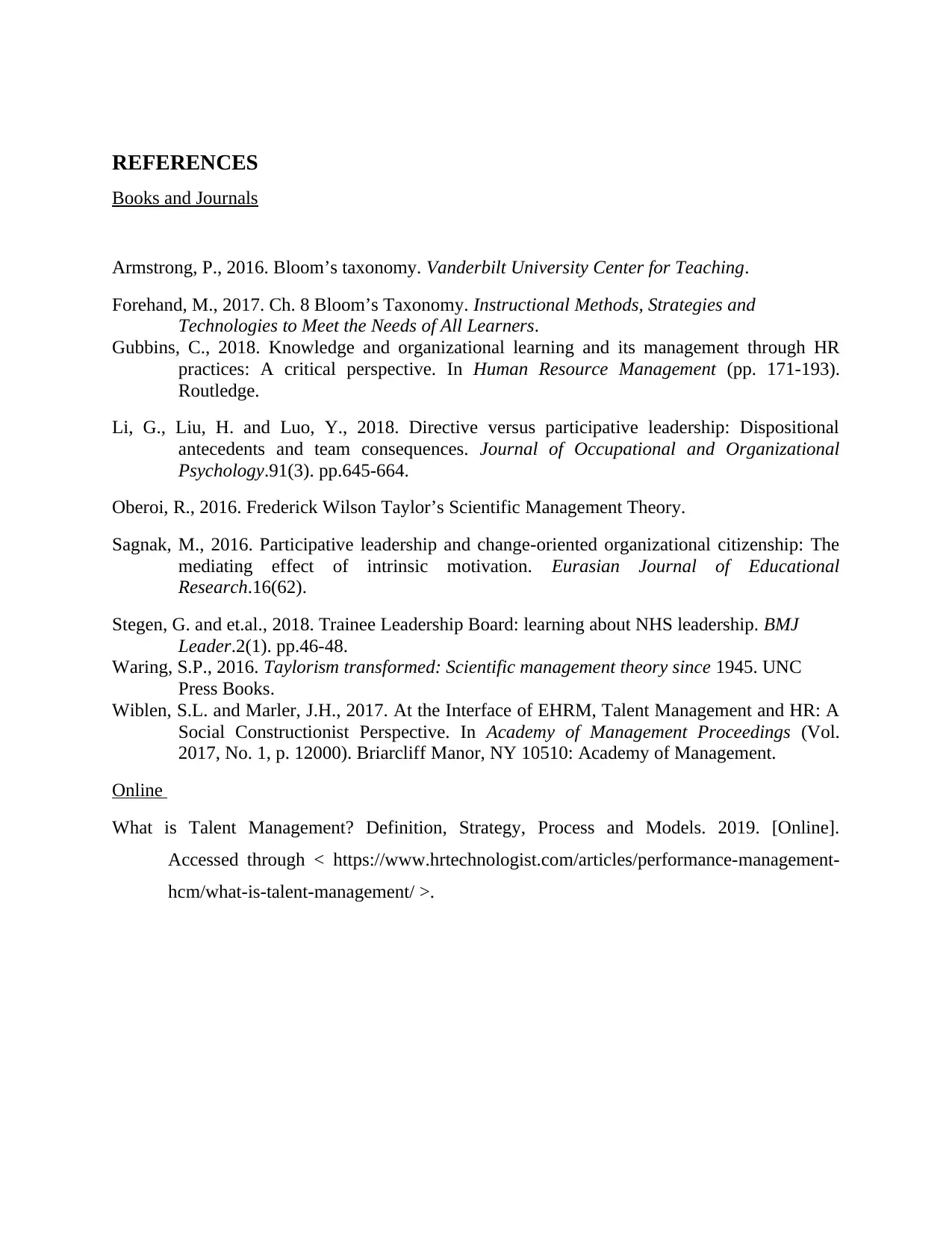
REFERENCES
Books and Journals
Armstrong, P., 2016. Bloom’s taxonomy. Vanderbilt University Center for Teaching.
Forehand, M., 2017. Ch. 8 Bloom’s Taxonomy. Instructional Methods, Strategies and
Technologies to Meet the Needs of All Learners.
Gubbins, C., 2018. Knowledge and organizational learning and its management through HR
practices: A critical perspective. In Human Resource Management (pp. 171-193).
Routledge.
Li, G., Liu, H. and Luo, Y., 2018. Directive versus participative leadership: Dispositional
antecedents and team consequences. Journal of Occupational and Organizational
Psychology.91(3). pp.645-664.
Oberoi, R., 2016. Frederick Wilson Taylor’s Scientific Management Theory.
Sagnak, M., 2016. Participative leadership and change-oriented organizational citizenship: The
mediating effect of intrinsic motivation. Eurasian Journal of Educational
Research.16(62).
Stegen, G. and et.al., 2018. Trainee Leadership Board: learning about NHS leadership. BMJ
Leader.2(1). pp.46-48.
Waring, S.P., 2016. Taylorism transformed: Scientific management theory since 1945. UNC
Press Books.
Wiblen, S.L. and Marler, J.H., 2017. At the Interface of EHRM, Talent Management and HR: A
Social Constructionist Perspective. In Academy of Management Proceedings (Vol.
2017, No. 1, p. 12000). Briarcliff Manor, NY 10510: Academy of Management.
Online
What is Talent Management? Definition, Strategy, Process and Models. 2019. [Online].
Accessed through < https://www.hrtechnologist.com/articles/performance-management-
hcm/what-is-talent-management/ >.
Books and Journals
Armstrong, P., 2016. Bloom’s taxonomy. Vanderbilt University Center for Teaching.
Forehand, M., 2017. Ch. 8 Bloom’s Taxonomy. Instructional Methods, Strategies and
Technologies to Meet the Needs of All Learners.
Gubbins, C., 2018. Knowledge and organizational learning and its management through HR
practices: A critical perspective. In Human Resource Management (pp. 171-193).
Routledge.
Li, G., Liu, H. and Luo, Y., 2018. Directive versus participative leadership: Dispositional
antecedents and team consequences. Journal of Occupational and Organizational
Psychology.91(3). pp.645-664.
Oberoi, R., 2016. Frederick Wilson Taylor’s Scientific Management Theory.
Sagnak, M., 2016. Participative leadership and change-oriented organizational citizenship: The
mediating effect of intrinsic motivation. Eurasian Journal of Educational
Research.16(62).
Stegen, G. and et.al., 2018. Trainee Leadership Board: learning about NHS leadership. BMJ
Leader.2(1). pp.46-48.
Waring, S.P., 2016. Taylorism transformed: Scientific management theory since 1945. UNC
Press Books.
Wiblen, S.L. and Marler, J.H., 2017. At the Interface of EHRM, Talent Management and HR: A
Social Constructionist Perspective. In Academy of Management Proceedings (Vol.
2017, No. 1, p. 12000). Briarcliff Manor, NY 10510: Academy of Management.
Online
What is Talent Management? Definition, Strategy, Process and Models. 2019. [Online].
Accessed through < https://www.hrtechnologist.com/articles/performance-management-
hcm/what-is-talent-management/ >.
Paraphrase This Document
Need a fresh take? Get an instant paraphrase of this document with our AI Paraphraser

1 out of 11
Related Documents
Your All-in-One AI-Powered Toolkit for Academic Success.
+13062052269
info@desklib.com
Available 24*7 on WhatsApp / Email
![[object Object]](/_next/static/media/star-bottom.7253800d.svg)
Unlock your academic potential
Copyright © 2020–2025 A2Z Services. All Rights Reserved. Developed and managed by ZUCOL.





